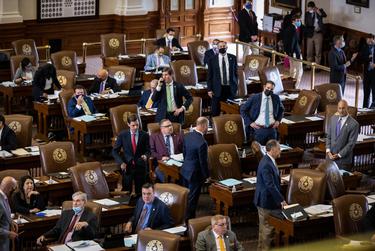Last Updated on May 3, 2021 – 9:20 PM CDT
This article originally appeared in The Texas Tribune: Read More
Lawmakers sit through hours of debate over police reform in the Texas House on April 29, 2021.
Credit: Jordan Vonderhaar for The Texas Tribune
Sign up for The Brief, our daily newsletter that keeps readers up to speed on the most essential Texas news.
Texas will close the books on its current budget cycle with an extra $725 million in the bank — which is welcome news as Texas Comptroller Glenn Hegar had predicted in January that the state would suffer a $1 billion shortfall due to the COVID-19 pandemic.
Hegar on Monday revised the revenue estimates for both the current budget cycle and the 2022-2023 biennium. Hegar increased the projection for state funds available for the 2022-2023 budget by $3 billion — to a total of $116 billion — as lawmakers race during the final weeks of the Legislature hammering out the spending plan.
“Our revised revenue forecast assumes continued economic growth through the next biennium, but uncertainty remains about the ultimate course of the economy and thus state revenue,” Hegar said during a Monday press conference. “Texas remains well-positioned to recover from the COVID outbreak and return to its norm of economic growth in excess of the national rate — if we haven’t already.”
The estimate doesn’t take into account all of the federal relief that has been sent to Texas over the past year by Congress through pandemic relief packages. State lawmakers have wrestled with how and who has the authority to spend that money. But Hegar’s estimate of all funds available for the budget includes federal money that could flow through state government. That “all funds” total of available revenue is now $294 billion, up from the $270.5 billion in his January estimate.
Last week, state officials announced they were releasing $11 billion of those federal funds designated to the state’s public schools, after several weeks of outcry by school officials.
In a letter to state leaders, Hegar said the revisions are based on increased state revenue projections, particularly increased tax revenue collected from oil and natural gas producers.
In July, as Texas was in the throes of the pandemic and many businesses were suffering, Hegar announced that the state was on track to end the biennium with a nearly $4.6 billion deficit. In January, he offered a slightly brighter picture and instead predicted a $1 billion shortfall, while estimating lawmakers would have $112.5 billion for the upcoming biennial budget..
Hegar pointed to an ample supply of COVID-19 vaccine doses and a rebounding economy in Texas and across the nation as reasons to be “optimistic about the near term” financial outlook. But he cautioned that Texas’ economy is also heavily reliant on international trade. Other countries have been dogged by vaccine shortages and some are facing devastating rises in COVID-19 cases.
“Supply-chain bottlenecks remain a problem for many industries, and rising case counts in other nations could make it more difficult to resolve issues connected with trade,” Hegar wrote to state leaders.
The announcement comes as members of the Texas Senate and House this week begin to hash out differences in the state’s 2022-2023 spending plan that has already been passed by both chambers.
Hegar said he doesn’t anticipate Monday’s announcement will “substantially change” the Legislature’s spending plan this year.
“It would possibly just put them in a better position when they enter back in next legislative session,” Hegar said.
